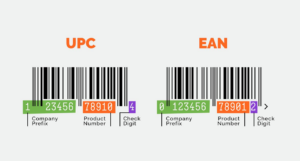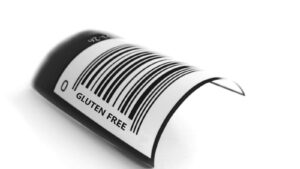When you go shopping, you see lots of products with black and white bars and numbers on them. These are called Universal Product Codes (UPC). UPCs are used to identify products and help stores keep track of their inventory. In this article, we will learn what UPCs are, how they work, why they are important, and how they are used in different industries.
What Is a Universal Product Code (UPC)?
A Universal Product Code – UPC is a type of barcode that is used to identify products. It consists of a series of black and white bars and a set of numbers. Each UPC is unique to a specific product. This means that no two products will have the same UPC.
Parts of a UPC
A UPC has two main parts: the barcode and the numbers. Here is what each part does:
Barcode
The barcode is the series of black and white bars. These bars can be scanned by a barcode scanner. Each bar has a different width, and the pattern of the bars represents the product’s unique code.
Numbers
Below the barcode, you will see a set of numbers. These numbers also represent the product’s unique code. The numbers are there so that if the barcode cannot be scanned, the code can still be entered manually.
How Does a UPC Work?
A UPC works by using a unique code to identify a product. Here is how it works:
Assigning a Code
Every product gets a unique UPC. This code is assigned by the manufacturer or a UPC-issuing organization.
Printing the Code
The UPC is printed on the product’s packaging. This includes both the barcode and the numbers.
Scanning the Code
When you buy a product, the cashier scans the barcode with a barcode scanner. The scanner reads the pattern of the bars and converts it into a number.
Identifying the Product
The scanned number is sent to the store’s computer system.

The computer system uses this number to identify the product, look up its price, and update the inventory.
Why Is UPC Important?
UPCs are very important for several reasons. Here are some of the main benefits of using UPCs:
Easy Identification
UPCs make it easy to identify products. Each UPC is unique, so there is no confusion about which product it represents.
Fast Checkout
UPCs help make the checkout process faster. Cashiers can scan the barcode quickly, which saves time compared to entering the price manually.
Accurate Inventory Management
UPCs help stores keep track of their inventory. When a product is sold, the UPC is scanned, and the store’s inventory system is updated to help stores restock products.
Reduced Errors
Using UPCs reduces the chances of errors. Scanning a barcode is more accurate than typing in a product code or price manually.
How Are UPCs Used in Different Industries?
UPCs are used in many different industries. Here are some examples of how they are used:
Retail
In retail stores, UPCs are used to identify products, look up prices, and manage inventory. When you buy a product, the cashier scans the UPC, and the store’s computer system processes the sale.
Manufacturing
In manufacturing, UPCs are used to track products through the production process. Each product gets a UPC, which helps manufacturers keep track of where each product is in the production line.
Healthcare
In healthcare, UPCs are used to identify medical products and supplies. This helps hospitals and clinics keep track of their inventory and make sure they have the supplies.
Food Industry
In the food industry, UPCs are used to track food products from the farm to the store. This helps ensure that food is safe and can be traced back to its source.
How to Get a UPC for Your Product
If you want to sell a product, you will need to get a UPC for it. Here is how you can get a UPC:
Join a UPC-issuing Organization
To get a UPC, you need to join a UPC-issuing organization. The most well-known organization is GS1.
Register Your Company
Once you join GS1, you need to register your company. You will receive a unique company prefix. This prefix will be part of every UPC you create.
Assign Product Numbers
After you get your company prefix, you can start assigning product numbers. Each product number is combined with your company prefix to create a unique UPC.
Print the UPC
Once you have created a UPC, you need to print it on your product’s packaging. Make sure the barcode numbers are clear and easy to scan.
Tips for Using UPCs
Here are some tips to help you use UPCs effectively:
Make Sure Barcodes Are Clear
Make sure the barcodes on your products are clear and easy to scan. If the barcode is damaged or blurry, it might not scan properly.
Keep Track of Your UPCs
Keep a record of all the UPCs you have assigned to your products. This will help you avoid assigning the same UPC to more than one product.
Update Your Inventory System
Make sure your inventory system is updated with the correct UPCs. This will help you keep track of your products and manage your inventory effectively.
Train Your Staff
Make sure your staff knows how to use UPCs and barcode scanners.

Proper training will help ensure that everything runs smoothly.
Common Questions About UPCs
Here are some common questions people have about UPCs:
Do All Products Need a UPC?
Not all products need a UPC, but having one can make it easier to sell and track your products. Most retailers require products to have a UPC.
Can I Use the Same UPC for Different Products?
No, each product must have its own unique UPC. Using the same UPC for different products can cause confusion and errors.
Do I Need to Renew My UPCs?
Once you get a UPC, it is yours to use as long as you need it. However, you might need to renew your membership with the UPC-issuing organization, like GS1.
Can I Create My Own UPCs?
No, you cannot create your own UPCs. You need to get them from a UPC-issuing organization like GS1.
Conclusion
A Universal Product Code (UPC) is a type of barcode used to identify products. It consists of black and white bars and a set of numbers. UPCs are important because they make it easy to identify products, speed up the checkout process, help manage inventory, and reduce errors.

